Kernels with a kick: Quality protein maize improves child nutrition
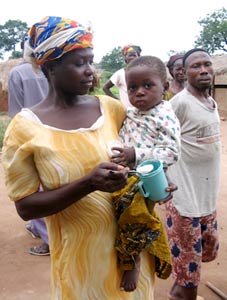
It looks and tastes like any other maize, but hidden inside each bite of quality protein maize (QPM) are specialized natural molecules waiting to give the diner an extra boost. A new study evaluates the nutritional impact of QPM on target populations.
Eating quality protein maize (QPM) increases the growth rate of moderately malnourished children who survive on a maize-dominated diet, according to a new study co-authored by five scientists, including two CIMMYT maize experts.
QPM grain is a biofortified, non-transgenic food that provides improved protein quality to consumers. It looks and tastes like normal maize, but QPM contains a naturally-occurring mutant maize gene that increases the amount of two amino acids—lysine and tryptophan—necessary for protein synthesis in humans. The total amount of protein in QPM is not actually increased, but rather the protein is enhanced so that it delivers a higher benefit when consumed by monogastric beings, like humans and pigs. Drawing on three decades of previous studies on QPM and using sophisticated statistical analysis, the paper “A meta-analysis of community-based studies on quality protein maize,” published in Food Policy, shows that when children suffering from malnutrition in maize-dependent areas consume QPM instead of conventional maize, they benefit from a 12% increased growth rate for weight and a 9% increased growth rate for height.
“We tried to bring together all the relevant work we could find on QPM and analyze and discuss it as transparently as possible,” said Nilupa Gunaratna, statistician at the International Nutrition Foundation and the paper’s lead author. “We discussed all the strengths and weaknesses of past studies, and took these into account in our evaluation. We also proceeded very conservatively, trying different methods, studying the effects of individual studies and outliers. In every approach, we came to the same conclusion: QPM has a positive effect on the growth of undernourished infants and young children for whom maize is a staple food.”
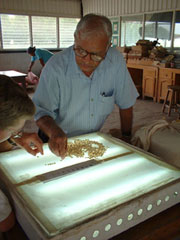
Give the people what they eat
Maize is the third-most important cereal crop for direct consumption (after rice and wheat), and is particularly significant in developing areas, such as Africa, where it is the main food source for more than 300 million people. In 12 developing countries, it accounts for more than 30% of total dietary protein. And though maize alone cannot provide all the nutrients needed for a healthy diet, maize with extra essential nutrients can go a long way toward helping the nearly 200 million children in poor nations who suffer stunted growth from malnutrition and for whom a diversified diet is currently unattainable.
“Staple foods are the cheapest foods, and the poorer you are, the more you depend on them, which often does not provide a balanced diet,” said co-author Kevin Pixley, who divides his time between CIMMYT and HarvestPlus. “We would all prefer to see each and every person eating a healthy and balanced diet, but that isn’t always possible. Biofortification is one part of the strategy to help combat malnutrition.”
QPM complexities
Though QPM is more nutritious than conventional maize and many of its varieties yield as well as or better than popular conventional maize varieties, widespread acceptance of QPM remains elusive. Of the 90 million hectares of maize grown in Mexico, Central America, sub-Saharan Africa, and Asia, only an estimated 1% or less is QPM.
Many seed companies lack interest in QPM because of the research costs and challenges of assuring its superior nutritional quality. If QPM is grown next to fields of conventional maize, cross-pollination will dilute the QPM trait, and QPM also requires separate storage and quality testing/monitoring. This and the fact that the enhanced maize brings no market premium—largely because its quality trait is not visibly distinguishable—have often deterred seed companies from marketing QPM altogether.
Yet in areas where there has been a substantial effort to promote it and make quality seed available, QPM has gained ground. For example, in 1992 Ghana released its first QPM variety, Obatanpa. Obatanpa is an open-pollinated variety, meaning its grain can be saved by farmers and re-sown as seed without any major decline in yield. In 2005, it was calculated that Obatanpa accounted for over 90% of improved seed sales in Ghana. In 2008, Wayne Haag of the Sasakawa Africa Association estimated that 350,000 hectares of QPM were grown in Ghana, making it the world’s largest QPM grower. Strong support and effort by multidisciplinary institutions, including the Ghanaian government, made this possible. Four of the QPM studies used in the meta-analysis were based in Ghana. Obatanpa’s high and stable yields and end-use quality have made it popular not only in Ghana but in several other sub-Saharan African countries, where it has been released under other names.
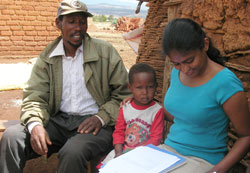
Fortifying future research
The authors of the QPM meta-analysis—two statisticians, an economist, a nutritionist, and a plant breeder—hope its clear results will finally dissuade QPM critics, many of whom have questioned whether QPM offers nutritional benefits for humans, and that the paper will lead to renewed efforts to explore improved nutrition through biofortified crops. “While there is still interesting and important nutritional research to be done on QPM, I hope the focus will start to shift from whether QPM has a benefit to how QPM can be promoted, disseminated, and used by farmers and consumers to have the most impact,” said Gunaratna. CIMMYT is currently involved in several QPM projects, including the QPM Development (QPMD) project in Africa, which is funded by the Canadian International Development Agency (CIDA). Launched in 2003, the project uses QPM as a key tool for improving food security, nutrition, and the incomes of resource-poor farming families in four countries (Ethiopia, Kenya, Tanzania, and Uganda). In the project’s first five years, seven new QPM varieties were released (bringing the total in the region to 12) and education efforts resulted in 270 field days attended by over 37,000 farmers, roughly 40% of whom were women. CIDA also funds AgroSalud, a five-year project that started in 2005 to extend the benefits of nutritionally improved staple crops to Latin America and the Caribbean. In 2002, two CIMMYT scientists received the World Food Prize for their work to develop QPM.
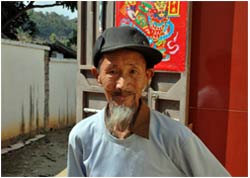
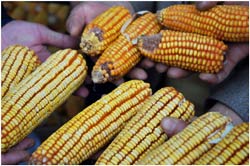
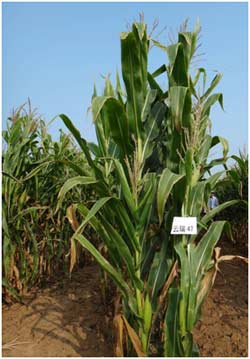


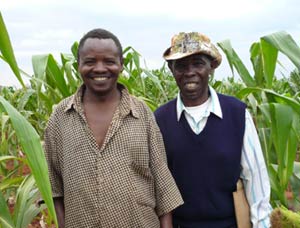 In the 2006-07 cropping season, 82 registered maize seed companies produced the bulk of just over 100,000 tons of improved maize seed that were marketed in the major maize producing countries of eastern and southern Africa (excluding South Africa) — enough to sow 35% of the maize land in those countries.
In the 2006-07 cropping season, 82 registered maize seed companies produced the bulk of just over 100,000 tons of improved maize seed that were marketed in the major maize producing countries of eastern and southern Africa (excluding South Africa) — enough to sow 35% of the maize land in those countries.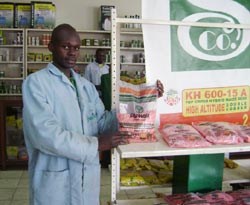
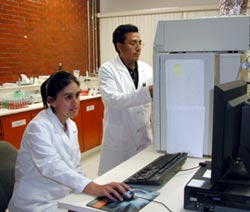 Breeding knowledge combined with cutting-edge laboratory analysis will produce maize rich in vital nutrients.
Breeding knowledge combined with cutting-edge laboratory analysis will produce maize rich in vital nutrients.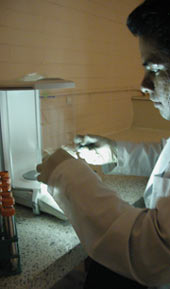
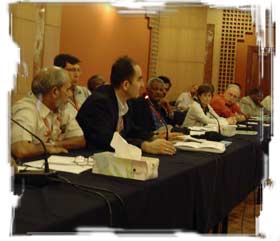 Global Rust Initiative tackles a clearly present danger.
Global Rust Initiative tackles a clearly present danger.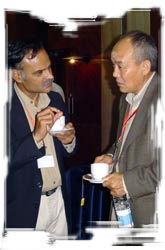
 In March, CIMMYT scientists continued their pursuit of drought tolerant wheat with the second field trial of transgenic lines carrying the DREB gene, given to CIMMYT by Japan International Research Center for Agricultural Sciences
In March, CIMMYT scientists continued their pursuit of drought tolerant wheat with the second field trial of transgenic lines carrying the DREB gene, given to CIMMYT by Japan International Research Center for Agricultural Sciences 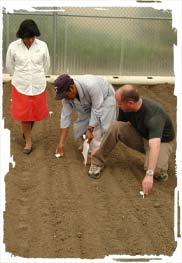 This second trial narrows the focus of investigation to four transgenic lines and uses a larger plot to ensure better control and analysis. It will also expose the experimental lines and control plants to both watered and drought conditions to determine their respective performance.
This second trial narrows the focus of investigation to four transgenic lines and uses a larger plot to ensure better control and analysis. It will also expose the experimental lines and control plants to both watered and drought conditions to determine their respective performance.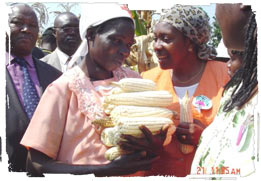 CIMMYT maize helps villagers quadruple their yields.
CIMMYT maize helps villagers quadruple their yields.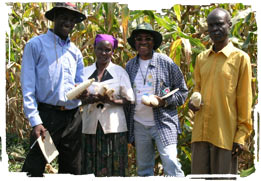
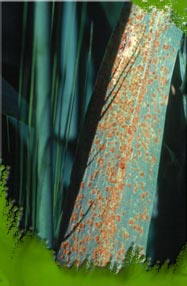 Every 1990-term US dollar invested in CIMMYT’s wheat genetic improvement over the past 40 years has generated at least 27 times its value in benefits from leaf rust resistance breeding in spring bread wheat alone, according to a recent CIMMYT study entitled “The Economic Impact in Developing Countries of Leaf Rust Resistance Breeding in CIMMYT–Related Spring Bread Wheat.”
Every 1990-term US dollar invested in CIMMYT’s wheat genetic improvement over the past 40 years has generated at least 27 times its value in benefits from leaf rust resistance breeding in spring bread wheat alone, according to a recent CIMMYT study entitled “The Economic Impact in Developing Countries of Leaf Rust Resistance Breeding in CIMMYT–Related Spring Bread Wheat.”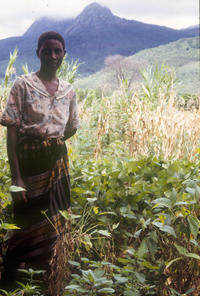 CIMMYT has entered into a collaborative research program to increase household and regional food security and incomes, as well as economic development, in eastern and southern Africa, through improved productivity from more resilient and sustainable maize-legume farming systems. Known as “Sustainable intensification of maize-legume cropping systems for food security in eastern and southern Africa” (SIMLESA), the program aims to increase productivity by 30% and reduce downside risk by 30% within a decade for at least 0.5 million farm households in those countries, with spill-over benefits throughout the region. In addition to CIMMYT, the program involves the
CIMMYT has entered into a collaborative research program to increase household and regional food security and incomes, as well as economic development, in eastern and southern Africa, through improved productivity from more resilient and sustainable maize-legume farming systems. Known as “Sustainable intensification of maize-legume cropping systems for food security in eastern and southern Africa” (SIMLESA), the program aims to increase productivity by 30% and reduce downside risk by 30% within a decade for at least 0.5 million farm households in those countries, with spill-over benefits throughout the region. In addition to CIMMYT, the program involves the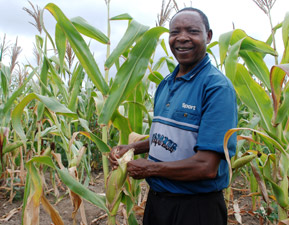 Many of us often underestimate the importance of water on our daily lives – that is until the taps run out of water or the well runs dry. For farmers, their lives are intimately connected to the abundance or lack of water. Many farmers in the developing world produce crops which are dependent on unpredictable patterns of rainfall. For these farmers, water is not only a resource, but truly the source of life.
Many of us often underestimate the importance of water on our daily lives – that is until the taps run out of water or the well runs dry. For farmers, their lives are intimately connected to the abundance or lack of water. Many farmers in the developing world produce crops which are dependent on unpredictable patterns of rainfall. For these farmers, water is not only a resource, but truly the source of life. Demand for maize has popped up across Asia, but much of the grain is enjoyed by poultry, not people. In Bangladesh, maize is a fairly new crop, yet demand in this country already mirrors that of neighboring nations like China and India. A recent CIMMYT report explores these emerging trends and the efforts to incorporate sustainable and economically viable maize cropping systems into a traditionally rice-based country.
Demand for maize has popped up across Asia, but much of the grain is enjoyed by poultry, not people. In Bangladesh, maize is a fairly new crop, yet demand in this country already mirrors that of neighboring nations like China and India. A recent CIMMYT report explores these emerging trends and the efforts to incorporate sustainable and economically viable maize cropping systems into a traditionally rice-based country. The larger grain borer is taking a beating from CIMMYT breeders in Kenya as new African maize withstands the onslaught of one of the most damaging pests.
The larger grain borer is taking a beating from CIMMYT breeders in Kenya as new African maize withstands the onslaught of one of the most damaging pests.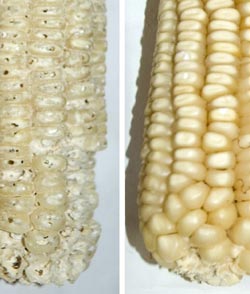 Even in Latin America, where it has co-evolved with natural predators, losses are significant. In Africa, where there are no similar predators to control the insect, its spread has been most dramatic. Attempts to introduce some of those predators to Africa to control the borer (a technique called biological control) have met with limited success and regionally concerted action is essential if biological control is to be effective across borer-infested areas. Researchers also studied the habits of the borer, hoping to find ways to reduce the damage it does. They discovered that it needs a solid platform, such as that provided by maize kernels still on the cob, before it will bore into a kernel. Unfortunately African farmers often store maize on the cob, increasing the potential for borer damage. By shelling the maize and storing the kernels off the cob, the damage can be reduced by small amounts, but losses are still very high. This is what makes the development of new varieties, where the resistance lies in the seed, so exciting.
Even in Latin America, where it has co-evolved with natural predators, losses are significant. In Africa, where there are no similar predators to control the insect, its spread has been most dramatic. Attempts to introduce some of those predators to Africa to control the borer (a technique called biological control) have met with limited success and regionally concerted action is essential if biological control is to be effective across borer-infested areas. Researchers also studied the habits of the borer, hoping to find ways to reduce the damage it does. They discovered that it needs a solid platform, such as that provided by maize kernels still on the cob, before it will bore into a kernel. Unfortunately African farmers often store maize on the cob, increasing the potential for borer damage. By shelling the maize and storing the kernels off the cob, the damage can be reduced by small amounts, but losses are still very high. This is what makes the development of new varieties, where the resistance lies in the seed, so exciting. CIMMYT researchers found resistance to the borer in the Center’s germplasm bank, in maize seed originally from the Caribbean. The bank holds 25,000 unique collections of native maize races. By using conventional plant breeding techniques, crossing those plants with maize already adapted to the conditions found in eastern Africa, Mugo and the breeding team were able to combine the resistance of the Caribbean maize with the key traits valued by Kenyan maize farmers. The maize was tested for resistance at the KARI research station in Kiboko, Kenya. Larger grain borers were placed in glass jars with a known weight of maize. Weight changes to the maize and a visual assessment of damage were recorded, allowing researchers to select the best lines. The result is new maize varieties that will benefit farmers in Kenya and help reduce Kenya’s dependence on imported maize for national food security.
CIMMYT researchers found resistance to the borer in the Center’s germplasm bank, in maize seed originally from the Caribbean. The bank holds 25,000 unique collections of native maize races. By using conventional plant breeding techniques, crossing those plants with maize already adapted to the conditions found in eastern Africa, Mugo and the breeding team were able to combine the resistance of the Caribbean maize with the key traits valued by Kenyan maize farmers. The maize was tested for resistance at the KARI research station in Kiboko, Kenya. Larger grain borers were placed in glass jars with a known weight of maize. Weight changes to the maize and a visual assessment of damage were recorded, allowing researchers to select the best lines. The result is new maize varieties that will benefit farmers in Kenya and help reduce Kenya’s dependence on imported maize for national food security.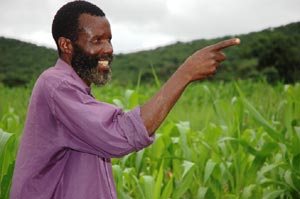 Farmer Hendrixious Zvamarima, of Shamva village, in Mashonaland Central Province, Zimbabwe, saw a neighbor who, instead of cultivating the soil, sowed his maize seed directly into unplowed soil and residues from last year’s crop. “I was wasting my time using the plow,” says Zvamarima, “so I decided to try the new methods.”
Farmer Hendrixious Zvamarima, of Shamva village, in Mashonaland Central Province, Zimbabwe, saw a neighbor who, instead of cultivating the soil, sowed his maize seed directly into unplowed soil and residues from last year’s crop. “I was wasting my time using the plow,” says Zvamarima, “so I decided to try the new methods.”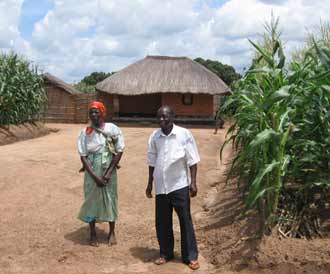
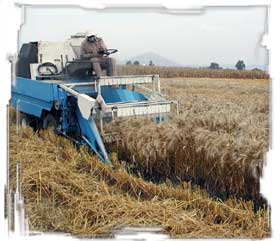 CIMMYT puts stem rust resistant seeds into partners’ hands for testing.
CIMMYT puts stem rust resistant seeds into partners’ hands for testing.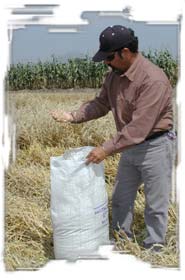 CIMMYT is not only distributing existing stem-rust-resistant wheats, but is part of efforts to breed materials that will lead to the release of new varieties. A range of sources, particularly lines that have shown Ug99 resistance in Kenya over two years’ testing, are being used to enhance the diversity of stem rust resistance in elite germplasm and valued cultivars. Singh and his team aim to create wheats with durable resistance to Ug99, by ‘pyramiding’ several minor resistance genes.
CIMMYT is not only distributing existing stem-rust-resistant wheats, but is part of efforts to breed materials that will lead to the release of new varieties. A range of sources, particularly lines that have shown Ug99 resistance in Kenya over two years’ testing, are being used to enhance the diversity of stem rust resistance in elite germplasm and valued cultivars. Singh and his team aim to create wheats with durable resistance to Ug99, by ‘pyramiding’ several minor resistance genes.